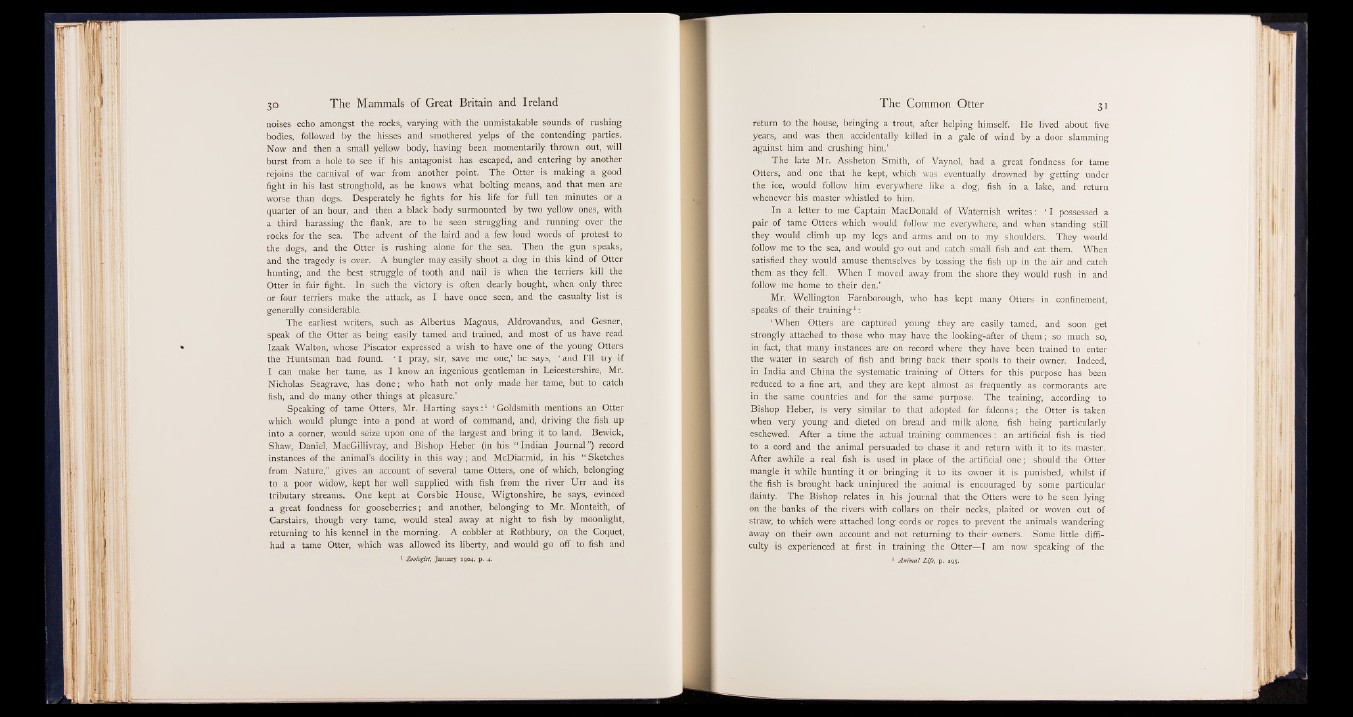
noises echo amongst the rocks, varying with the unmistakable sounds of rushing
bodies, followed by the hisses and smothered yelps of the contending parties.
Now and then a small yellow body, having been momentarily thrown out, will
burst from a hole to see if his antagonist has escaped, and entering by another
rejoins the carnival of war from another point. The Otter is making a good
fight in his last stronghold, as he knows what bolting means, and that men are
worse than dogs. Desperately he fights for his life for full ten minutes or a
quarter of an hour, and then a black body surmounted by two yellow ones, with
a third harassing the flank, are to be seen struggling and running over the
rocks for the sea. The advent of the laird and a few loud words of protest to
the dogs, and the Otter is rushing alone for the sea. Then the gun speaks,
and the tragedy is over. A bungler may easily shoot a dog in this kind of Otter
hunting, and the best struggle of tooth and nail is when the terriers kill the
Otter in fair fight. In such the victory is often dearly bought, when only three
or four terriers make the attack, as I have once seen, and the casualty list is
generally considerable.
The earliest writers, such as Albertus Magnus, Aldrovandus, and Gesner,
speak of the Otter as being easily tamed and trained, and most of us have read
Izaak Walton, whose Piscator expressed a wish to have one of the young Otters
the Huntsman had found. ‘ I pray, sir, save me one,’ he says, ‘ and I ’ll try if
I can make her tame, as I know an ingenious gentleman in Leicestershire, Mr.
Nicholas Seagrave, has done; who hath not only made her tame, but to catch
fish, and do many other things at pleasure.’
Speaking of tame Otters, Mr. Harting sa y s : 1 ‘ Goldsmith mentions an Otter
which would plunge into a pond at word of command, and, driving the fish up
into a corner, would seize upon one of the largest and bring it to land. Bewick,
Shaw, Daniel, MacGillivray, and Bishop Heber (in his “ Indian Journal”) record
instances of the animal’s docility in this w ay; and McDiarmid, in his “ Sketches
from Nature,” gives an account of several tame Otters, one of which, belonging
to a poor widow, kept her well supplied with fish from the river Urr and its
tributary streams. One kept at Corsbie House, Wigtonshire, he says, evinced
a great fondness for gooseberries; and another, belonging to Mr. Monteith, of
Carstairs, though very tame, would steal away at night to fish by moonlight,
returning to his kennel in the morning. A cobbler at Rothbury, on the Coquet,
had a tame Otter, which was allowed its liberty, and would go off to fish and
1 Zoologist, January 1904, p. 4.
return to the house, bringing a trout, after helping himself. He lived about five
years, and was then accidentally killed in a gale of wind by a door slamming
against him and crushing him.’
The late Mr. Assheton Smith, of Vaynol, had a great fondness for tame
Otters, and one that he kept, which was eventually drowned by getting under
the ice, would follow him everywhere like a dog, fish in a lake, and return
whenever his master whistled to him.
In a letter to me Captain MacDonald of.Waternish writes: ‘ 1 possessed a
pair of tame Otters which would follow me everywhere, and when standing still
they would climb up my legs and arms and on to my shoulders. They would
follow me to the sea, and would go out and catch small fish and eat them. When
satisfied they would amuse themselves by tossing the fish up in the air and catch
them as they fell. When I moved away from the shore they would rush in and
follow me home to their den.’
Mr. Wellington Farnborough, who has kept many Otters in confinement,
speaks of their training1 :
‘When Otters are captured young they are easily tamed, and soon get
strongly attached to those who may have the looking-after of them; so much so;
in fact, that many instances are on record where they have been trained to enter
the water in search of fish and bring back their spoils to their owner. Indeed,
in India and China the systematic training of Otters for this purpose has been
reduced to a fine art, and they are kept almost as frequently as cormorants are
in the same countries and for the same purpose. The training, according to
Bishop Heber, is very similar to that adopted for falcons; the Otter is taken
when very young and dieted on bread and milk alone, fish being particularly
eschewed. After a time the actual training commences: an artificial fish is tied
to a cord and the animal persuaded to chase it and return with it to its master.
After awhile a real fish is used in place of the artificial one;. should the Otter
mangle it while hunting it or bringing it to its owner it is punished, whilst if
the fish is brought back uninjured the animal is encouraged by some particular
dainty. The Bishop relates in his journal that the Otters were to be seen lying
on the banks of the rivers with collars on their necks, plaited or woven out of
straw, to which were attached long cords or ropes t'o prevent the animals wandering
away on their own account and not returning to their owners. Some little difficulty
is experienced at first in training the Otter—I am now speaking of the
1 Animal Life, p. 395.